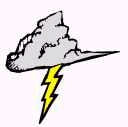Down
| 2. | If the arrow on a wind vane points north, the wind is moving ____. |
| 3. | This reaches from the ground to about 700 km above the Earth. |
| 5. | The earth's axis is not perpendicular to the plane of the earth's orbit around the sun. The axis is titled by about 23.5 ____. |
| 6. | In a cold front the ____ cold air mass slides in underneath the lighter warm air mass. |
| 7. | A device that measures precipitation. (2 words) |
| 8. | This is the layer of the atmosphere where most clouds and weather are located. |
| 9. | The name of a front is determined by its ____. |
| 12. | If Earth were upright in relation to the Sun, there would be no ____ on Earth. |
|
|
Across
| 1. | The change of water from its gas form to its liquid form. |
| 4. | The sound emitted by rapidly expanding gases that has been heated by lightning. |
| 10. | A severe thunderstorm that can produce large hail, damaging winds, and violent tornadoes. |
| 11. | The layer of the atmosphere where planes fly. The thin air is not suitable for humans, but planes run most efficiently in this layer of the atmosphere. |
| 13. | The instrument used to measure air pressure. |
| 14. | In the northern hemisphere, winter solstice occurs on ____ 21. |
| 15. | For a thunderstorm to develop, plenty of ____ in the lower atmosphere is required. |
| 16. | Some thunderstorms can produce damaging ___, tornados, and flash floods. |
| 17. | This is the coldest part of the atmosphere. Some large helium balloons can reach this height in the atmosphere. |
|














































































































































































































































































































































































































































































































































































































































































